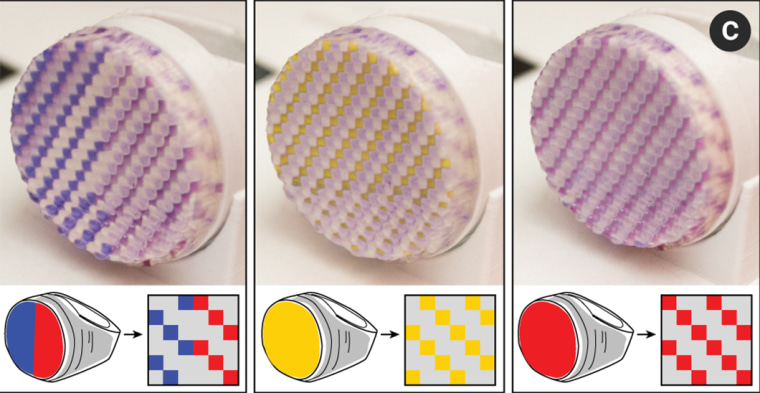What if you could change the color of your clothes and accessories anytime you wanted — turning a red shirt white just before an important business meeting, for example, or changing your earrings from gold to a bluish hue as you head out for a night on the town.
Researchers at MIT are one step closer to being able to pull off these seamless wardrobe changes, with a new study showing that ultraviolet (UV) light — possibly from a cellphone or other handheld device — can be used to change the color of 3D-printed apparel and accessories on the fly.
“We wanted to know, how can we update the color of an object at any time?” said study co-author Dr. Stephanie Mueller, an assistant professor at the school’s Computer Science and Artificial Intelligence Laboratory (CSAIL).
For their research, the scientists created simple plastic objects, including a chunky ring that starts out transparent but can be made to appear red, yellow, or blue. They say the same ColorMod technology eventually could be used to create clothing with similar color-changing properties.
The key to the new technology is a special photochromic ink, which shifts color when exposed to ultraviolet light. Currently, it takes about 25 minutes of light exposure to make the change, but Mueller said the process could be sped up by using a more powerful light or by adding more dye to the ink.
The recolored object holds its new hue even after the UV light is switched off, but Mueller said the color will slowly fade over the course of 16 to 20 hours. She added that scientists are working to make these colors last longer as well as to make more — and more vibrant — colors. The continuing evolution of 3D printers should help. “You can see the pixels are pretty coarse, but with 3D printing, resolutions are getting better and better every year,” she said.
Mueller said ColorMod was being developed with an eye toward sustainability.
“If you look at the rate at which consumers buy products, you can see that over the last decade, people just buy more and more stuff,” she said. “This creates a lot of waste, and our motivation was to say: can we give you something new every day without the need to require additional material and create waste?”
One day, ColorMod could be used to morph more than an object’s color. “The system we worked on for this particular project is just doing the color change, but the bigger question is: can we update other aspects of a product as well?” Mueller said. “Can we change the shape? Can we add functional aspects?”

